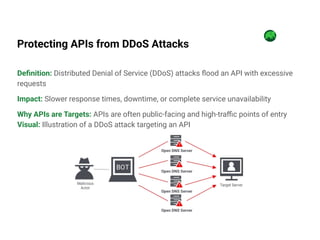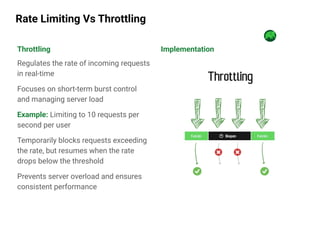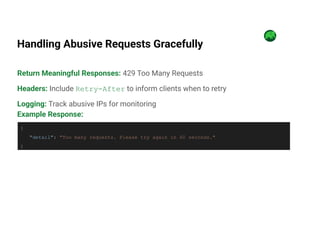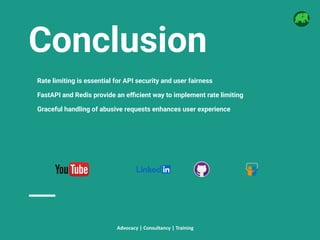REDIS + FastAPI: Implementing a Rate Limiter
- 1. Samuel Folasayo Protect Your API from Abuse with Redis & FastAPI technology for good Joe Nyirenda TechPrane Advocacy | Consultancy | Enablement
- 2. Learning Objectives ● Understand the importance of rate limiting for API security ● Learn how to implement a rate limiter using FastAPI middleware ● Explore Redis as a real-time backend for managing request limits ● Master techniques for handling abusive API requests gracefully
- 3. Protecting APIs from DDoS Attacks Definition: Distributed Denial of Service (DDoS) attacks flood an API with excessive requests Impact: Slower response times, downtime, or complete service unavailability Why APIs are Targets: APIs are often public-facing and high-traffic points of entry Visual: Illustration of a DDoS attack targeting an API
- 4. What is Rate Limiting? Definition: Controlling the number of requests a client can make to an API within a specified timeframe Purpose: Prevent server overload and abusive behavior Types of Rate Limiting: ○ Fixed Window ○ Sliding Window ○ Token Bucket
- 5. Why Rate Limiting is Essential Protect API Resources: Prevent resource exhaustion Improve User Experience: Ensure fair usage for all users Enhance Security: Block malicious actors and bots
- 6. Rate Limiting: Fixed Window
- 7. Rate Limiting: Sliding Window
- 8. Rate Limiting: Token Bucket
- 9. Rate Limiting Vs Throttling Controls the total number of requests a client can make within a specific timeframe Focuses on long-term usage and preventing abuse Example: Allowing 100 requests per hour per user Once the limit is reached, all subsequent requests are denied (usually with a 429 Too Many Requests response) Enforces fairness and prevents overuse of resources Rate Limiting Implementation
- 10. Rate Limiting Vs Throttling Regulates the rate of incoming requests in real-time Focuses on short-term burst control and managing server load Example: Limiting to 10 requests per second per user Temporarily blocks requests exceeding the rate, but resumes when the rate drops below the threshold Prevents server overload and ensures consistent performance Throttling Implementation
- 11. Client-Side Throttling Where? Implemented in the client application How? Limits the number of requests sent to the server Uses libraries like Lodash for web apps or equivalent mechanisms in mobile apps Commonly applied to user-triggered actions such as input fields or scrolling Purpose: Reduces redundant server calls, especially in event-heavy applications Example: A search bar that waits for a user to stop typing before sending a request to the server
- 12. Server-Side Throttling Where? Implemented on server infrastructure How? Monitors and enforces rate limits on incoming requests Tools like NGINX, HAProxy, or backend middleware (e.g., Django, Express.js) are used Returns error codes such as 429 Too Many Requests when limits are exceeded Purpose: Protects servers from overload or abuse due to high traffic volumes Example: An API that allows a maximum of 10 requests per second per user
- 13. Client vs. Server Throttling Aspect Client-Side Throttling Server-Side Throttling Location Client application Server Infrastructure Purpose Optimize requests before reaching server Protect server resources for overuse Implementation Handled using frontend logic or libraries Handled using backend tools or middleware
- 14. Implementation in FastAPI Adding middleware for rate limiting from fastapi import FastAPI, Request, HTTPException from redis import Redis app = FastAPI() redis = Redis(host='localhost', port=6379) @app.middleware("http") async def rate_limiter(request: Request, call_next): client_ip = request.client.host key = f"rate_limit:{client_ip}" count = redis.incr(key) if count == 1: redis.expire(key, 60) # Set expiration to 60 seconds if count > 10: raise HTTPException(status_code=429, detail="Too many requests") response = await call_next(request) return response Middleware processes each request Redis tracks request counts per client Limit set to 10 requests per minute
- 15. Using Redis for Real-time Rate Limiting Why Redis? High performance and low latency Expiry feature for resetting limits Redis Commands Used: INCR: Increment request count EXPIRE: Set expiration time for keys
- 16. Handling Abusive Requests Gracefully Return Meaningful Responses: 429 Too Many Requests Headers: Include Retry-After to inform clients when to retry Logging: Track abusive IPs for monitoring Example Response: { "detail": "Too many requests. Please try again in 60 seconds." }
- 17. Conclusion Rate limiting is essential for API security and user fairness FastAPI and Redis provide an efficient way to implement rate limiting Graceful handling of abusive requests enhances user experience Advocacy | Consultancy | Training

















